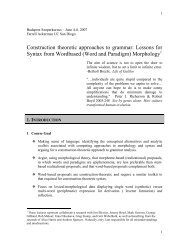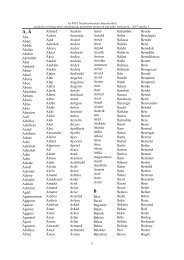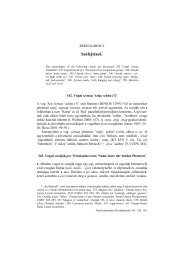Nyelvtudományi közlemények 91. kötet (1990)
Nyelvtudományi közlemények 91. kötet (1990)
Nyelvtudományi közlemények 91. kötet (1990)
Sie wollen auch ein ePaper? Erhöhen Sie die Reichweite Ihrer Titel.
YUMPU macht aus Druck-PDFs automatisch weboptimierte ePaper, die Google liebt.
SHEEP IN THE SAMOYED TUNDRAS 103<br />
well have been familiär with the sheep, it is rather natural to assume that<br />
the speakers of Proto-Nenets, in their essentially arctic environment, were<br />
completely ignorant of any such animal. The situation is, however, more<br />
complicated, for all of the Northern Samoyeds have preserved a Common<br />
Samoyedic term for another domestic animal, the horse, which is also completely<br />
stränge to their immédiate environment. Moreover, the Common<br />
Samoyedic appellation of the horse, */yUntA/ ~ */yUnta/ (SW 49), is<br />
a borrowing from Turkic, most probably deriving from the very period of<br />
the earliest contacts between Proto-Samoyedic and Proto-Bolgarian-Turkic<br />
(cf. e.g. Róna-Tas 1980. 380). It remains an enigma, how the word was able<br />
to survive during its migration, together with some Samoyedic-speaking<br />
proto-population, from the neighbourhood of the steppe zone up to the<br />
arctic tundras, where absolutely no horses were présent before the récent<br />
expansion of the Russians and the Komi. Whatever the explanation, if the<br />
word for the horse was able to survive, a word for the sheep could have<br />
survived equally well.<br />
Unfortunately, there is also a phonological problem connected with the<br />
comparison of Nenets /xu/ with the Turkic appellation of the sheep. Thus,<br />
altough most of the modern Turkic idioms suggest an earlier shape */kOy/<br />
scattered data such as Ancient Turkic qoj /kON/ ~ qojun /kOyUn/ (DTS<br />
453) require the reconstruction of the original shape of the word as something<br />
like */kONIn/. In fact, this reconstruction is confirmed by Mongolie<br />
xoni(n) (qonin) /kOnin/ 'sheep' (MED 965-966), a loanword from early<br />
Turkic, possibly Proto-Bolgarian-Turkic. What is more interesting here is<br />
that the word was also borrowed from early Turkic intő Proto-Selkup to yield<br />
*(kONAr), as attested in several southern and central dialects of language<br />
(cf. again Doerfer 1967 loc. cit. as well as Filippova 1983. 81). However, neither<br />
the original Turkic shape nor its adaptation in Selkup can have been<br />
the source of Nenets /xu/.<br />
The possibility of récent diffusion from modem Siberian Turkic into<br />
Nenets must also be dismissed, for between Siberian Turkic and Nenets<br />
there is a broad beit of Ob-Ugric and Selkup dialects in which the sheep is<br />
called either */a:c/ (both in Khanty and in Mansi, GOUV 123) or *|kONAr|<br />
(in Selkup). Obviously, the word /xu/ in Nenets cannot have come from this<br />
direction.<br />
Indeed, the etymological problem can be solved through rather simple<br />
reasoning, the clue to the correct solution being the fact that it was not the<br />
sheep but its skin that was first introduced to the Nenets. Consequently, we<br />
should not look for words with the meaning 'sheep', but, rather, for words<br />
with the meaning 'skin'. Now, the normal word for 'skin' in Komi is ku<br />
/ku/ 'Fell, Haut, Leder' (SWb. 494), and this is the answer to the whole<br />
Nyelvtudományi Közlemények <strong>91.</strong> <strong>1990</strong>.




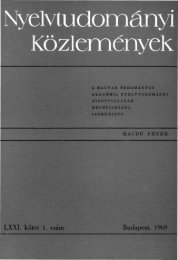

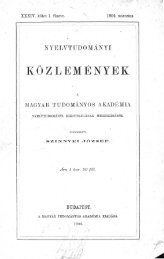
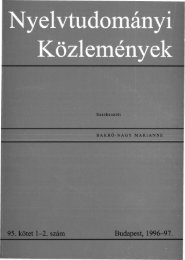
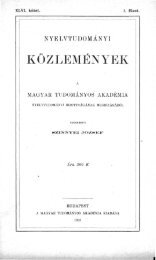
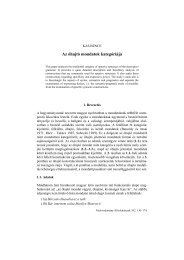
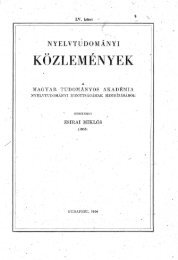
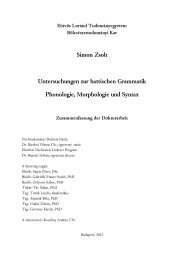
![Gósy Mária: A [p, t, k] mássalhangzók zöngekezdési ideje Bevezetés ...](https://img.yumpu.com/15682849/1/190x245/gosy-maria-a-p-t-k-massalhangzok-zongekezdesi-ideje-bevezetes-.jpg?quality=85)

